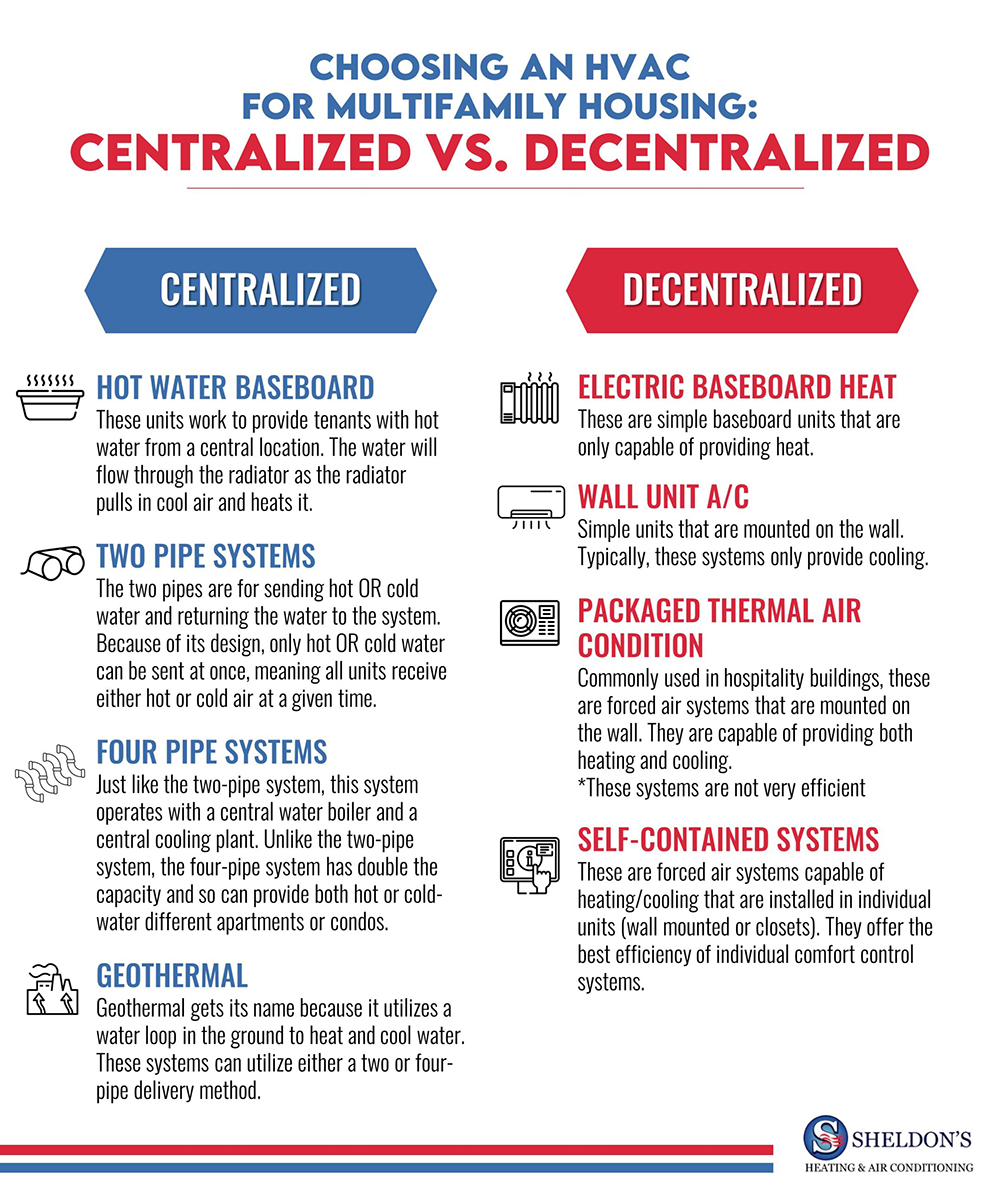Updated: October 28, 2023
Managing a multifamily housing complex can be a challenging balance of constantly justifying your qualitative and quantitative initiatives. From ensuring the financial security that keeps your building running to maintaining your tenant’s comfort, it can be a constant back and forth.
Perhaps the most evident example is the building’s HVAC system. Your tenants will want as much control of their comfort as possible. However, achieving the heating and cooling needs of dozens of families can be expensive and energy-inefficient. To achieve the right balance of fiscal responsibility and comfort, you’ll want to pay close attention to the details within this guide and work closely with your dedicated HVAC services provider.
Peak load flexibility
Choosing a system that is rigid in its capacity is a major risk for multi-family property owners. Estimating how much energy will be required for the system to function throughout the year is extremely challenging. Owning a system that can withstand a variety of peak energy loads will ensure that no matter what the weather brings or what your tenants do, your system can handle it.
Individual comfort controls
This is the key differentiator between centralized and decentralized HVAC systems for apartment complexes. A centralized system, while being more efficient, will not provide temperature controls in each housing unit. This can be a major negative for tenant retention.

Decentralized HVAC systems offer each family or individual their unit for heating and/or cooling. While this may lead to certain tenants choosing less efficient comfort settings, it can go a long way towards accommodating a variety of occupants long-term. Consider the long-term benefits of your building’s reputation for treating tenants vs. the long-term costs of a more expensive HVAC system. We recommend securing tenants to sustain your building and saving on HVAC expenses through other means.
Ease of maintenance
On larger systems, routine maintenance is an absolute necessity and even still, repairs will be needed. Choosing a system that is relatively easy to maintain, will ensure that HVAC contractors don’t have to charge double the time to perform their work. You will also save money throughout your system’s life if parts are cheaper and easier to obtain for your contractor. Consider these ongoing expenses when choosing your new multifamily HVAC system.
Centralized vs. Decentralized
For a multi-family complex, owners have two options for HVAC systems – Centralized and decentralized. Centralized systems are more expensive upfront but are much more energy efficient. Centralized systems work to heat the entire building from a centralized location (typically the basement or a penthouse). This makes it challenging to achieve comfort control for all tenants but allows the owner to control energy costs. Centralized systems are often preferred in larger complexes due to their energy savings and upfront cost (once the complex reaches a certain number of units, it is no longer cheaper to install individual systems for each tenant).
Below are the options for centralized (left) and decentralized (right) HVAC systems for multi-family complexes. The systems are in order from cheapest to most expensive to install as well as from least to most energy efficient.
Centralized
- Hot water baseboard
- Two pipe systems
- Four pipe systems
- Geothermal
These units work to provide tenants with hot water from a central location. The water will flow through the radiator as the radiator pulls in cool air and heats it.
The two pipes are for sending hot OR cold water and returning the water to the system. Because of its design, only hot OR cold water can be sent at once, meaning all units receive either hot or cold air at a given time.
Just like the two-pipe system, this system operates with a central water boiler and a central cooling plant. Unlike the two-pipe system, the four-pipe system has double the capacity and so can provide both hot or cold-water different apartments or condos.
Geothermal gets its name because it utilizes a water loop in the ground to heat and cool water. These systems can utilize either a two or four-pipe delivery method.
Decentralized
- Electric baseboard heat
- Wall unit A/C
- Packaged thermal air condition
- Self-contained systems
These are simple baseboard units that are only capable of providing heat.
Simple units that are mounted on the wall. Typically, these systems only provide cooling.
Commonly used in hospitality buildings, these are forced air systems that are mounted on the wall. They are capable of providing both heating and cooling.
*These systems are not very efficient
These are forced air systems capable of heating/cooling that are installed in individual units (wall mounted or closets). They offer the best efficiency of individual comfort control systems.
Contact Sheldon's Heating, Air Conditioning & Plumbing Today
To ensure that your building’s heating and cooling needs are being executed effectively and efficiently, work with an HVAC company in Riverside with the knowledge, capacity, and honesty to provide quality work. Whether you just need routine AC maintenance, furnace replacement, air conditioner installation, or emergency cooling repairs, Sheldon's Heating, Air Conditioning & Plumbing’s has the team you can trust to get the job done right the first time. Contact us for a quote today!



